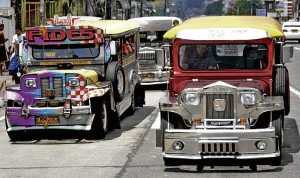Gov’t to retrofit Metro jeepneys to lessen carbon emissions

The Climate Change Commission said on Wednesday it was planning to introduce a P26-billion program to be sourced from international private sector for the modification of the engines of the jeepneys over a five-year period.
“Diesel-driven jeepneys, buses and trucks are responsible for 70 percent of black soot emissions in our urban centers,” Commissioner Heherson T. Alvarez said in a statement emanating from Doha, Qatar, where he leads the Philippine delegation in ongoing climate change talks. The talks are actually the 18th conference of parties in the United Nations Framework Convention on Climate Change.
The plan is to retrofit the jeepneys using Australian technology that will reduce soot emissions by as much as 80 percent, he elaborated in a telephone interview.
Alvarez, a former senator and environment secretary, cited a study by the Asian Development Bank estimating that some 500,000 public utility vehicles, mostly jeepneys, produce 22,000 metric tons of soot emissions per year.
Air pollution costs the Philippine economy $1.5 billion annually, in large part due to diesel vehicles, according to the Philippine Environment Monitor.
Article continues after this advertisement“The country spends over $400 million in direct costs annually – some 0.6 percent of the country’s gross domestic product – on health expenses caused by pollution,” Alvarez said.
Article continues after this advertisementAnother study by the World Bank estimates that some 5,000 annual premature deaths, or 12 percent of all deaths in Metro Manila, the highest of any city in the Philippines, are due to respiratory and cardiovascular diseases from exposure to the city’s pollution, Alvarez said.
Soot emitted by jeepneys is composed of “extremely fine airborne particles believed to be among the largest man-made contributors to global warming because they absorb solar radiation and heat the atmosphere,” Alvarez said.
But soot has not been recognized as a greenhouse gas, he noted.
The Philippines, along with a number of allied countries, is making a push to include black carbon on the list of greenhouse gases blamed for global warming at the Doha meetings, Alvarez said.
“By doing so, governments can attack black carbon and immediately address climate change by as much as 50 percent,” he said.
A recent scientific study found that black carbon “is now emerging as the second most important, but previously overlooked, factor in global warming,” Alvarez said.
He said studies showed that reducing soot emissions from diesel engines could slow the melting of glaciers in the Arctic more effectively and more economically than any other quick fix.
“If governments radically cut levels of black carbon and methane through technologies that are now available, then we could cut the rate of global warming by 50 percent,” he said.
Alvarez said this would increase the chance of keeping temperature rise below 2 degrees Celsius, thereby slowing the advance of climate change by several decades.
In a related development, Environment Secretary Ramon Paje sought public support in bringing down air pollution levels in Metro Manila to acceptable standards.
Metro Manila’s air, he said, has actually become less polluted, registering declines in both the amount of total suspended particulates (TSP) and the level of particulate matter 10 microns in diameter or smaller (PM10) in the urban center.
As of the third quarter, the TSP level in the National Capital Region was recorded at 106ug/Ncm (micrograms per normal cubic meter), or 16ug/Ncm short of the acceptable level of 90ug/Ncm set by the World Health Organization.
Paje noted that when the Aquino administration came in June 2010, the TSP level in Metro Manila was at 166ug/Ncm. The current PM10 level of 77ug/Ncm in Metro Manila is also approaching the annual guideline threshold of 60ug/Ncm, he said.